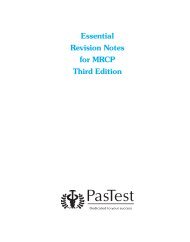EMQs for Medical Students - PasTest
EMQs for Medical Students - PasTest
EMQs for Medical Students - PasTest
You also want an ePaper? Increase the reach of your titles
YUMPU automatically turns print PDFs into web optimized ePapers that Google loves.
E M Q s F O R M E D I C A L S T U D E N T S – V O L U M E 2<br />
4. C – Carcinomatosis<br />
This woman has signs of disseminated malignancy, with ascites, hepatomegaly and<br />
multiple pulmonary metastases. The most likely cause is an ovarian cancer, which often<br />
presents late with evidence of intra-abdominal metastases. The diagnosis can be<br />
confirmed by ultrasound of the pelvis and/or an ascitic tap, which might show<br />
evidence of malignant cells.<br />
5. F – Crohn’s disease<br />
This young man has returned from Nepal with a history suggestive of an acute infective<br />
diarrhoeal illness. The negative stool cultures and microscopy do not rule out an<br />
infective cause but make it less likely. The endoscopic findings and biopsy results,<br />
however, suggest that this is in fact his first presentation of Crohn’s disease. The patient<br />
requires steroids, nutritional supplementation and education regarding his diagnosis.<br />
7. ABDOMINAL PAIN I<br />
1. C – Ascending cholangitis<br />
This man has ascending cholangitis with the classic Charcot’s triad of fever, rigors<br />
and jaundice. The low blood pressure is common in this disorder because of the<br />
effect of endotoxaemic shock caused by the Gram-negative organisms (mainly<br />
Escherichia coli) that cause this condition. This shock should be corrected and the<br />
sepsis treated aggressively because this condition carries a 30% mortality. A plain<br />
abdominal film might confirm the diagnosis (showing gas in the biliary tree). The<br />
commonest cause is gallstones.<br />
2. B – Appendicitis<br />
This patient has appendicitis, as evidenced by the short history of right iliac fossa<br />
pain and associated gastrointestinal upset with a leucocytosis. The diagnosis is a<br />
clinical one and one would also expect to find evidence of peritonism (guarding,<br />
rebound tenderness) in the right iliac fossa. Other causes of an identical picture<br />
could include Crohn’s ileitis, but this is uncommon if there is no preceding history of<br />
abdominal symptoms.<br />
3. A – Acute pancreatitis<br />
This patient has acute pancreatitis, as evidenced by the history of alcohol abuse and the<br />
clinical presentation. The results confirm the dehydration and hypokalaemia associated<br />
with the prolonged vomiting, which is a marked feature of this abdominal condition.<br />
The raised WCC occurs secondary to pancreatic inflammation but might also indicate<br />
impending septic complications.<br />
4. E – Diverticulitis<br />
This patient has diverticulitis. This is very common <strong>for</strong> a woman of her age. The long<br />
previous history of pain and change in bowel habit is indicative of diverticulosis, and<br />
this has become complicated by inflammation in a diverticulum, leading to the<br />
increase in symptoms and peritonism in the left iliac fossa.<br />
5. J – Ureteric colic<br />
This patient has ureteric colic, which is caused by a calculus obstructing the right<br />
ureter. The appearance of a patient unable to get com<strong>for</strong>table in any position is classic<br />
166

















